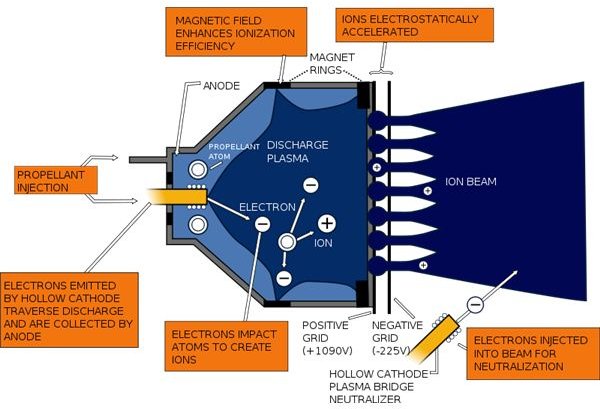Propulsion in Space--Getting Through the Solar System Faster
Raising the Speed Limit
Today, getting to the planets in our solar system is a long, drawn out journey. A trek to Mars takes nine months. To get to the outer worlds we sometimes are forced to slingshot around other planets to build up speed, or resort to even more draconian methods to reach the outer reaches in a reasonable time.
What is needed are types of propulsion in space that can continually accelerate a spacecraft on its journey, so the craft keeps gaining velocity, rather than losing it to the pull of gravitational forces. One that does that is flying now, and a more powerful one is being tested. It is an ION engine.
An ion engine propelled Deep Space 1 (DS1) to a rendezvous with Comet Borelly in 2001, and another ion engine sped the DAWN spacecraft to the asteroid belt for close encounters with three asteroids.
An ion engine relies not on exhausting tons of propellant to produce acceleration, but on using mere ounces. This means the thrust of an ion engine is very low—also mere ounces. DS1’s engines produced 0.02 lbs of thrust. But it makes up for that with an incredibly high exhaust velocity—in the case of the DS1 and DAWN engines, 25 miles per second. Theoretically, an ion engine’s Ev (Exhaust Velocity) is unlimited, determined only by the amount of electrical power used to generate the ions.
An ion engine generally uses xenon as fuel. This is stripped of its electrons by a high electric charge to create ions. The ions are then accelerated by an electric field as exhaust to propel the spacecraft. The diagram below depicts DS1’s engine.
The ion engine can operate continuously, giving the spacecraft ever-increasing speed, albeit at small increments. DS1’s engines increased its speed by 7900 mph over its flight time. DAWN’s engines will run for 5000 hours.
Even more advanced ion engines are in the works.
Plasma Propulsion
Ion engines are called Constant Specific Impulse (CSI) engines because their Isp does not vary during their operation. The other type engine now being developed is a Variable Specific Impulse (VSI) engine—a plasma engine. In this device, a fuel, usually hydrogen, is ionized. Very high frequency radio waves then heat it to extreme temperature to create plasma. Magnetic fields contain the plasma within the engine and direct it out the nozzle to produce low levels of thrust.
NASA was working on one of these until 2005. Its development has now been turned over to a private company—Ad Astra Rocket Co. It is called the Variable Specific Impulse Magneto-plasma Rocket, or VASIMR. It was to be tested on the ISS in 2011. Instead, some parts of it will be tested on the space station in the 2013 to 2014 time frame.
As shown in the diagram below, the VASIMR system consists of three major magnetic cells numbered in the diagram as ‘1’, ‘‘4’, and ‘‘6’. First, a neutral gas, typically hydrogen, is injected into cell 1 and ionized by the Helicon antenna. Next, this charged gas is heated to reach the desired density in the engine’s central cell, 4, by electromagnetic waves, similar to what happens in a microwave oven. The plasma is trapped by the magnetic field that is generated by the magnetic coils. It can be heated to 10 million degrees K.
Then, the heated plasma enters the nozzle at cell 6, where the plasma detaches from the magnetic field and is expelled as exhaust to provide thrust.
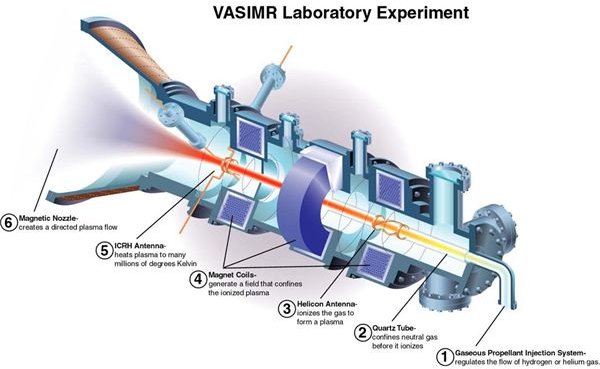
VASIMR can change its thrust and Isp by changing the fraction of power sent to the Helicon antenna vs. the ICRH (ion cyclotron resonance heating) antenna. The helicon antenna is used to ionize gas injected from the gas injector. The ICRH antenna heats the gas and accelerates the particles before these particles are exhausted to space. When more power is sent to the Helicon antenna, more gas is ionized, which means more ions are ejected. But because the total system power level is constant, power sent to the ICRH antenna decreases, which means these ions exit with a lower velocity. These low-speed, large quantity ions create a high thrust, low Isp engine. On the other hand, when less power is sent to the Helicon antenna and more power is sent to the ICRH antenna, a small amount of gases are ionized and they are accelerated to a higher exit velocity. These high-speed ions produce a low thrust, high Isp rocket engine.
A recent doctoral thesis at the Georgia Institute of Technology (Georgia Tech) indicated a VASIMR type engine could cut the transit time to Mars from that nine months to one month. The diagram below illustrates the method of using VASIMR’s variable capability.The length of the lines indicate thrust levels. Note as well that the direction of the thrust varies as the spacecraft progresses along its trajectory. This is to catch up with Mars as it approaches the planet.
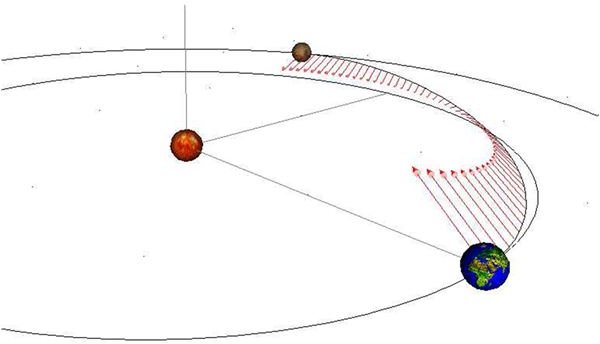
And you will note as well that about half way to Mars, the thrust direction reverses. This is the kicker of continuous acceleration. You can’t just keep the pedal to the metal. At the half way point you have to apply the brakes. In space, this means you have to turn the ship around and begin deceleration.
More Power From the Atom
But these propulsion methods work only in space. They still must be lofted into space by the brute force of some form of rocket engine. Today’s chemical rockets are powerful, but have their limitations.
NASA is working again on more powerful engine types—nuclear propulsion. The agency was developing at least two types of nuclear propulsion systems in the ‘60s. One was dubbed Project Rover. It was based on work done in the ‘50s by the Atomic Energy Commission (AEC) on nuclear rockets. The AEC built and ground tested a nuclear rocket successfully many times. NASA picked up the technology and continued its development. The agency reached a proof of concept engine dubbed NERVA– Nuclear Engine for Rocket Vehicle Applications. NERVA was not meant to fly but its successor was, and was meant to power the second stage of the SATURN 5. However, environmental outrage over possible (but unfounded) radiation contamination caused the project to be cancelled.
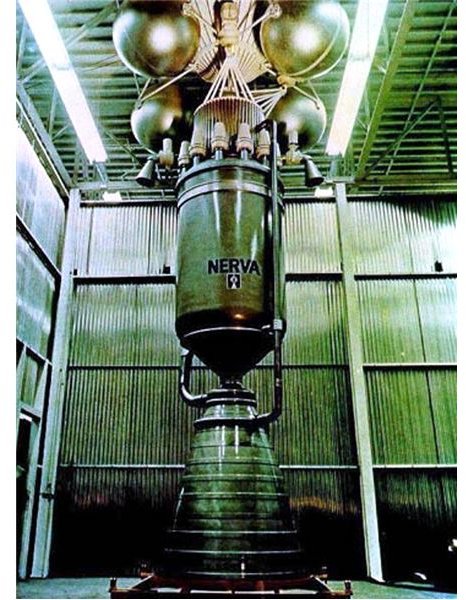
NERVA could achieve an Isp of 850. The Space Shuttle’s main engines have an Isp of 452 in space. Modern versions of NERVA are expected to have Isps as high as 2000. It produced thrust of only 250,000 lbs but it was a small test engine. The concept could easily have been upgraded to several million pounds. The engine was operated for as long as 90 minutes and could be stopped and restarted as many as 28 times.
Some Booming Systems
Another nuclear system being studied is known as Medusa. This rocket uses small nuclear bombs exploded periodically beneath what is effectively a sail to propel the ship.
Medusa is a variation on a nuclear rocket NASA was seriously working on in the mid-‘60s called Project Orion. Orion also used small nuclear bombs for propulsion, but they were exploded at the rear of the ship and pushed against a pusher plate. Orion seems more practical than Medusa because the blast of the bombs with Medusa engulf the vehicle. Work with Orion was halted because of passage of the Limited Nuclear Test Ban Treaty in 1963.
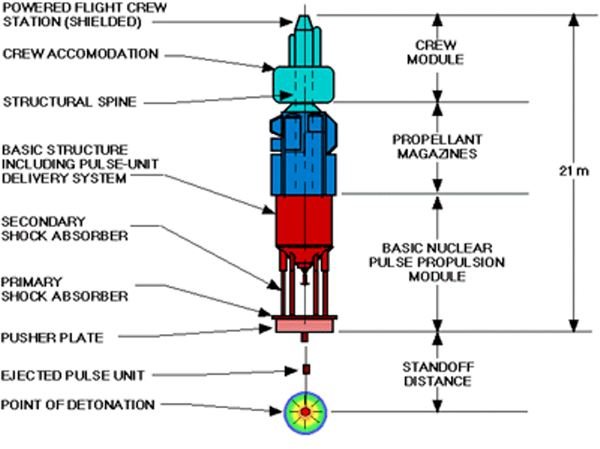
Both Medusa and Orion theoretically have the capability of achieving specific impulses (Isp) as high as 100,000. This could propel a ship to a good fraction of the speed of light. That would cut transit time to even the outer planets to a few weeks. It could take us to the nearer stars.
But these systems can be used only for propulsion in space, at least at this time. No one would sit still for having nuclear bombs, albeit how small, exploded in the atmosphere to launch a spacecraft.
Sources and Credits
Sources:
https://ntrs.nasa.gov/archive/nasa/casi.ntrs.nasa.gov/19920005899_1992005899.pdf
https://www.physicsdaily.com/physics/Nuclear_thermal_rocket
https://smartech.gatech.edu/bitstream/1853/4904/1/sakai_tadashi_200412_phd.pdf
Credits:
VSI trajectory diagram: Georgia Tech: https://smartech.gatech.edu/bitstream/1853/4904/1/sakai_tadashi_200412_phd.pdf
VASIMR diagram: NASA https://spaceflight.nasa.gov/shuttle/support/researching/aspl/images/vasimr.jpgVASIMR
All other images: NASA
